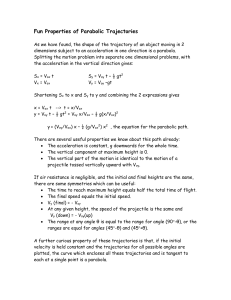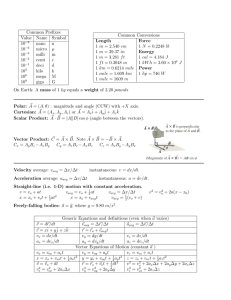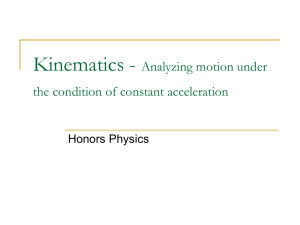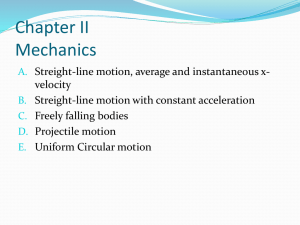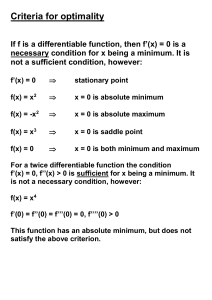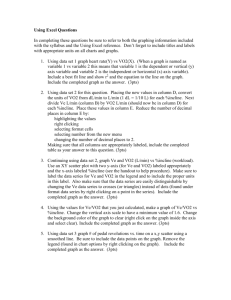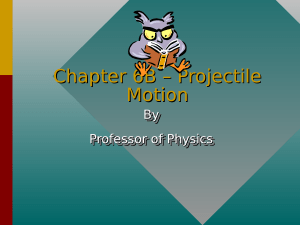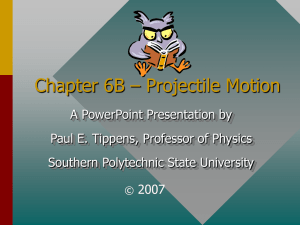1 Test 1 sample
advertisement
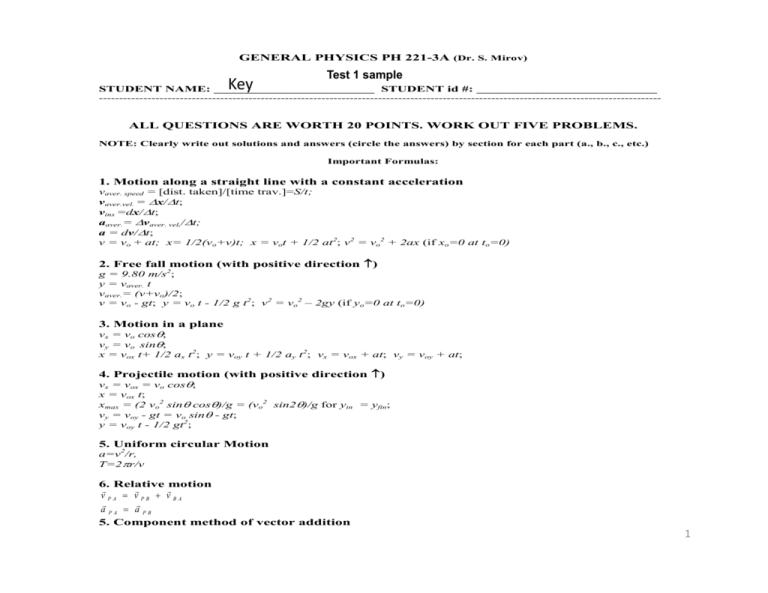
GENERAL PHYSICS PH 221-3A (Dr. S. Mirov) Test 1 (09/17/07) Key Test 1 sample STUDENT NAME: ________________________ STUDENT id #: ___________________________ ------------------------------------------------------------------------------------------------------------------------------------------- ALL QUESTIONS ARE WORTH 20 POINTS. WORK OUT FIVE PROBLEMS. NOTE: Clearly write out solutions and answers (circle the answers) by section for each part (a., b., c., etc.) Important Formulas: 1. Motion along a straight line with a constant acceleration vaver. speed = [dist. taken]/[time trav.]=S/t; vaver.vel. = Δx/Δt; vins =dx/Δt; aaver.= Δvaver. vel./Δt; a = dv/Δt; v = vo + at; x= 1/2(vo+v)t; x = vot + 1/2 at2; v2 = vo2 + 2ax (if xo=0 at to=0) 2. Free fall motion (with positive direction ↑) g = 9.80 m/s2; y = vaver. t vaver.= (v+vo)/2; v = vo - gt; y = vo t - 1/2 g t2; v2 = vo2 – 2gy (if yo=0 at to=0) 3. Motion in a plane vx = vo cosθ; vy = vo sinθ; x = vox t+ 1/2 ax t2; y = voy t + 1/2 ay t2; vx = vox + at; vy = voy + at; 4. Projectile motion (with positive direction ↑) vx = vox = vo cosθ; x = vox t; xmax = (2 vo2 sinθ cosθ)/g = (vo2 sin2θ)/g for yin = yfin; vy = voy - gt = vo sinθ - gt; y = voy t - 1/2 gt2; 5. Uniform circular Motion a=v2/r, T=2πr/v 6. Relative motion G G G v PA = v PB + v BA G G a PA = a PB 5. Component method of vector addition 1 A = A1 + A2 ; Ax= Ax1 + Ax2 and Ay = Ay1 + Ay2; A = Ax2 + Ay2 ; θ = tan-1 ⏐Ay /Ax⏐; G G The scalar product A a ⋅ b =ab cosφ G G a ⋅ b = (axiˆ + ay ˆj + azkˆ) ⋅ (bxiˆ + by ˆj + bzkˆ) G G a ⋅ b =axbx + ayby + azbz G G The vector product a × b = (axiˆ + a y ˆj + azkˆ) × (bxiˆ + by ˆj + bzkˆ) iˆ ˆj kˆ ay az ax az ˆ ax ay G G G G ˆ ˆ −j +k = a × b = −b × a = ax ay az = i by bz bx by bx bz bx by bz = (aybz − byaz )iˆ + (azbx − bzax ) ˆj + (axby − bxay )kˆ ------------------------------------------------------------------------------------------------------------------------------------------- 2 1. Starting at time t = 0, an object moves along a straight line. Its coordinate in meters is given by x(t) = 75t ‐1.0t3, where t is in seconds. What is its acceleration when it momentarily stops? dx = 75 − 3.0t 2 1) v = dt 2) Time at which the object will stop corresponds to v = 0 ⇒ 75 − 3.0t 2 = 0; ⇒ t=5s dv = −6.0t 3) a = dt 4) ⇒ for t=5s a = −30 m 2 s 3 2. 4 3. 5 4. 6 G G G G G 5. Let R = S × T and θ is the angle between S and T when they are drawn with their tails at the same point. Which of the following is not true? G G G A. R = S T sin θ It is true by definition. G G G B. − R = T × S it is true since iˆ G G a × b = ax bx ˆj ay by kˆ ay a z = iˆ by bz az a − ˆj x bz bx az ˆ ax +k bx bz ay = by = (a y bz − by a z )iˆ + (a z bx − bz a x ) ˆj + ( a x by − bx a y )kˆ iˆ G G b × a = bx ax ˆj by ay kˆ by ˆ bz = i ay az bz b − ˆj x az ax bz ˆ bx +k ax az by = ay G G ˆ ˆ ˆ = −( a y bz − by a z )i − ( a z bx − bz a x ) j − ( a x by − bx a y )k = −(b × a ) G G G G C. R ⋅ S = 0 . It is true since R ⋅ S = RS cos 90 = 0 G G G G D. R ⋅ T = 0 It is true since R ⋅ T = RT cos 90 = 0 G G E. S ⋅ T = 0 It is not true since cosθ ≠ 0 7 6. According to an ancient Greek source, a stone throwing machine on one occasion achieved a range of 730 m. If this is true, (a) What must have been the minimal initial speed of the stone as it was ejected from the engine? (b) When ejected with this speed, how long would the stone have taken to reach its target? Given: x = 730 m θ =45D Find (a) vo = ? (b) t f Solution : vo2 sin 2θ vo2 (a ) x = = ⇒ vo = xg = (730m) ⋅ (9.8m / s 2 ) = 84.6m / s g g (b) Consider y motion. Given: 1) Time of flight corresponds to y=0; 2) a=-9.8 m/s2 3) voy = vo sin 45D = 84.6sin 45 = 59.8m / s Use equation (3) to find time of flight −2voy −2(59.8m / s ) 1 0=voy t f + at f 2 ⇒ t f = = = 12.2 s 2 2 a ( −9.8m / s ) 8 7. y A ball is thrown horizontally from the top of a 20-m high hill. It strikes the ground at an angle of 45°. With what speed was it thrown? v a) Consider motion along y direction. Choose the origin point at the top of the hill and y axis directed vertically upwards. The ball is in a free fall from the height of 20 m Given: 1) voy = 0; 2) y = −20m; 3)a = −9.8m / s2. Find vy =? Use equation 4. v2y =voy2 + 2ay; ⇒ vy = 2ay = −2(−9.8m / s2 )(−20m) = 19.8m / s b) Since a ball strikes the ground at 45D final x component of velocity equal final y component of velocity ⇒ v = vox = vx = 20m / s 9 8. A girl wishes to swim across a river to a point directly opposite as shown. She can swim at 2m/s in still water and the river is flowing at 1m/s. At what angle θ with respect to the line joining the starting and finishing points should she swim? G v gb − velocity of a girl with respect to the bank of the river G vwb − velocity of a water with respect to the bank of the river G v gw − velocity of a girl with respect to the still water G G G According to the relative motion rule vgb = vwb + v gw ⇒ θ = arctan( vwb 1 ) = arctan( ) = 3 × 101 v gw 2 D 10 9. A girl jogs around a horizontal circle with a constant speed. She travels one fourth of a revolution, a distance of 25m along the circumference of the circle, in 5.0 s. What is the magnitude of her acceleration? ( a ) Find speed of the uniform circular motion. since qurter of a full revolution travel corresponds to 25 m, and time it takes equal to 5.0 s the speed of the motion is 25/5.0=5.0m/s (b) Find radius r of a circular trajectory. 2π r = 25m, ⇒ r = 15.9m 4 (c) Find centripital acceleration. v 2 (5m / s )2 a= = = 1.6m / s 2 r (15.9m ) 11
